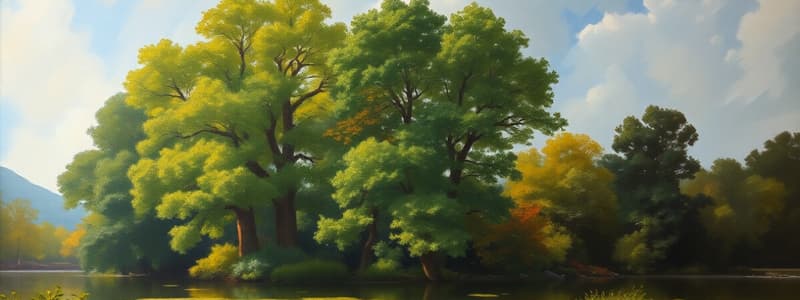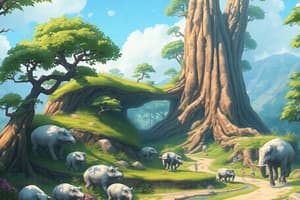Podcast
Questions and Answers
What type of plate boundary occurs when two tectonic plates move towards each other?
What type of plate boundary occurs when two tectonic plates move towards each other?
- Passive boundary
- Convergent boundary (correct)
- Transform boundary
- Divergent boundary
The troposphere is primarily responsible for containing the ozone layer.
The troposphere is primarily responsible for containing the ozone layer.
False (B)
What is the primary function of contour plowing in soil conservation?
What is the primary function of contour plowing in soil conservation?
To reduce soil erosion by plowing along the contours of the land.
The three main soil textures represented in the texture triangle are sand, silt, and __________.
The three main soil textures represented in the texture triangle are sand, silt, and __________.
Match the following types of agriculture with their characteristics:
Match the following types of agriculture with their characteristics:
Which of the following best describes the process of photosynthesis?
Which of the following best describes the process of photosynthesis?
In a food chain, carnivores are known as producers.
In a food chain, carnivores are known as producers.
What is the main difference between Gross Primary Productivity (GPP) and Net Primary Productivity (NPP)?
What is the main difference between Gross Primary Productivity (GPP) and Net Primary Productivity (NPP)?
The _____ cycle involves the process of nitrogen fixation.
The _____ cycle involves the process of nitrogen fixation.
Match the following types of succession to their definitions:
Match the following types of succession to their definitions:
Which of the following is NOT a biotic factor in an ecosystem?
Which of the following is NOT a biotic factor in an ecosystem?
Island biogeography suggests that larger and closer islands have fewer species than smaller, distant ones.
Island biogeography suggests that larger and closer islands have fewer species than smaller, distant ones.
What is the primary role of decomposers in an ecosystem?
What is the primary role of decomposers in an ecosystem?
Flashcards
Biosphere
Biosphere
The layer of Earth that includes all living things, from microscopic organisms to giant trees and animals.
Weathering
Weathering
The process of breaking down rocks, soil, and minerals through physical and chemical means, creating the foundation for soil formation.
Erosion
Erosion
The process of moving weathered material from one location to another, often by wind, water, or ice.
Monocropping
Monocropping
Signup and view all the flashcards
Crop rotation
Crop rotation
Signup and view all the flashcards
Gross Primary Productivity (GPP)
Gross Primary Productivity (GPP)
Signup and view all the flashcards
Net Primary Productivity (NPP)
Net Primary Productivity (NPP)
Signup and view all the flashcards
Carbon Cycle
Carbon Cycle
Signup and view all the flashcards
Food Chain
Food Chain
Signup and view all the flashcards
Food Web
Food Web
Signup and view all the flashcards
Biodiversity
Biodiversity
Signup and view all the flashcards
Ecological Succession
Ecological Succession
Signup and view all the flashcards
Population Density
Population Density
Signup and view all the flashcards
Study Notes
Ecosystem Structure and Function
- Biotic Factors: Living components: producers (autotrophs), consumers (herbivores, carnivores, omnivores), decomposers (bacteria, fungi).
- Abiotic Factors: Non-living components: climate, soil, water, nutrients.
- Food Chains/Webs and Trophic Levels: Energy transfer follows the 10% rule.
- Energy Flow: Gross Primary Productivity (GPP) is total energy captured by producers, Net Primary Productivity (NPP) is energy available after respiration. Ecosystems vary in efficiency (e.g., rainforests vs. deserts).
Biogeochemical Cycles
- Carbon Cycle: Involves photosynthesis, respiration, fossil fuels, and ocean absorption.
- Nitrogen Cycle: Includes nitrogen fixation, nitrification, assimilation, ammonification, and denitrification.
- Phosphorus Cycle: Primarily driven by rock weathering; no gaseous phase; linked with fertilizer use.
- Water Cycle: Processes like evaporation, transpiration, precipitation, and runoff.
Ecosystem Services
- Ecosystem services are categorized as provisioning (e.g. food), regulating (e.g. climate), supporting (e.g. nutrient cycling), and cultural.
Biodiversity
- Biodiversity Levels: Include genetic diversity (variation within species), species diversity (variety of species), and ecosystem diversity (range of habitats and communities).
- Ecosystem Services: Biodiversity enhances resilience and human needs.
- Natural Disruptions: Examples include volcanoes, earthquakes, and wildfires.
- Human Impacts: These include habitat destruction, invasive species, overharvesting, pollution, and climate change.
- Island Biogeography: Island size and distance from the mainland influence species richness. Larger, closer islands typically support more species.
Ecological Succession
- Primary Succession: Colonization of barren areas (e.g., lava flows).
- Secondary Succession: Recovery after a disturbance (e.g., farming, fires).
Population Dynamics
- Population characteristics: Size, density, distribution, sex ratio, and age structure.
- Population Growth: Exponential (J-curve) versus logistic (S-curve) growth; carrying capacity.
- Reproductive Strategies: r-selected species (high reproduction, low survival) vs. K-selected species (low reproduction, high survival).
- Survivorship Curves: Illustrate patterns of survival throughout a species' life span (Types I, II, III).
Human Population
- Growth Trends: Population growth patterns and the demographic transition model (pre-industrial to post-industrial).
- Factors: Fertility rates, doubling time (rule of 70), urbanization impacts.
Earth Systems and Resources
- Earth's Systems: The lithosphere (rock), hydrosphere (water), atmosphere (air), biosphere (life).
- Plate Tectonics: Convergent, divergent, and transform boundaries; associated with volcanoes, earthquakes, mountain formation.
- Soil Systems: Soil horizons (O, A, B, C); soil texture (sand, silt, clay); permeability and fertility. Soil conservation practices (contour plowing, terracing, crop rotation).
- Atmosphere: Layers (troposphere, stratosphere); weather vs. climate; El Niño/La Niña effects.
- Water Resources: Freshwater availability, aquifers, overdraft (e.g., Ogallala Aquifer), watershed management.
Land and Water Use
- Agriculture: Industrial vs. subsistence farming; monoculture impacts, soil degradation, and sustainable practices.
- Forestry: Clear-cutting vs. selective logging; deforestation effects; sustainable practices.
- Mining: Surface (strip) and subsurface mining; environmental effects.
- Urban Development: Urban sprawl, heat islands, waste management, smart growth principles.
- Fishing and Aquaculture: Overfishing impacts, sustainable fishing methods, aquaculture pros and cons.
Studying That Suits You
Use AI to generate personalized quizzes and flashcards to suit your learning preferences.




